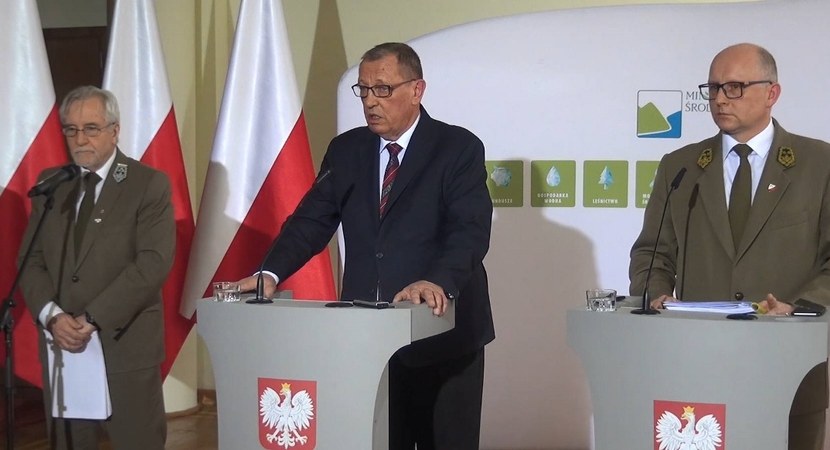CONFERENCE ON THE BIAŁOWIEŻA FOREST
“If remedial actions are not taken, further stretches of the Białowieża Forest, which used to be a pride of Polish forestry and an extraordinary facility of cultural and natural heritage, will die back” said Minister Jan Szyszko during the conference.
The meeting was also attended by the Director-General of the State Forests Konrad Tomaszewski and the Undersecretary of State for the Environment Andrzej Konieczny.
The Minister of the Environment strongly emphasized the massive die-back of trees in the Białowieża Forest. This very crisis, caused mainly by the bark beetle gradation, mostly affects spruce and the number of dead spruce trees in the Forest can be counted in millions.
“This crisis is accompanied by a very disturbing phenomenon which is a rapid decline of precious and natural habitats, also those important for the EU and protected within the EU network Natura 2000. The degradation and withering of the Białowieża Forest’s tree stands is followed by the degradation of the habitats; the amount of precious, protected species of flora and fauna is decreasing” – said Minister.
In order to save it, the Programme for the Białowieża Forest has been developed with the main aim is to hinder the destruction of the habitats of Community importance.
“The Białowieża Forest requires active protection. Leaving Białowieża alone will lead to its inner devastation. As members of the European Union, we are obliged to obey the law and implement Natura 2000 programme, therefore we have to take care of the habitats that we’ve established”said Minister of the Environment.
The first phase of activities involves full inventory of natural resources, which has been in progress since April 2016. For the first time in the history of the Białowieża Forest, a complex examination of the entire ecosystem has been conducted. About 200 experts, including scientists and foresters, participated in the inventory which covered the entire area of the Forest, in three forest districts (Hajnówka, Browsk and Białowieża) as well as in the Białowieża National Park.
“It was a unique operation. Not only did we inventory animal and plant species, but we also completed these records with cultural studies. All of this was done in order to verify whether leaving Białowieża only to forces of nature is the solution that would sustain biodiversity at the same level as it was at the moment when NATURA 2000 areas were designated said Director General of the State Forests Konrad Tomaszewski.
“The inventory leaves no doubt that currently we face the impoverishment of natural habitats. The results have shown that in order to preserve biodiversity we need to resume the implementation of the Plan of Protection Tasks.”
Jan Tabor, the responsible for inventory of the Białowieża Forest’s natural resources, added: “We will not be held accountable for ideology we follow but how many species we’ve lost because this is a measurable effect showing how we do protect a particular area.”
One of the proposals within the recovery scheme for the Białowieża Forest is to divide its area into reference zones. According to some NGOs demands, one-third of its territory has already been left without any recovery treatment and with no human interference. The remaining two-thirds of the Białowieża Forest is subject to active protection in accordance with Natura 2000 requirements. Sanitation cuts, which are to prevent a spread of diseases, and alternative planting are performed there.
Minister Jan Szyszko emphasized that there is an extraordinary richness of wild animal species in the Białowieża Forest.
“Poland is a unique country on a global scale, considering wide variety of domestic animal and plant species. Basing on Polish experience I offered the EU countries help in restoring habitats and populations of wild animals such as the European bison. This experiment emulated from Polish solutions, could significantly enrich biodiversity in other European countries, where degradation and extinction of domestic animal species occurred in many places”said Minister.
Five EU member states reacted to this offer: Bulgaria, Czech Republic, Netherlands, Germany and Romania.
Undersecretary of State Andrzej Konieczny emphasized that the Ministry of the Environment holds talks with the European Commission and the UNESCO World Heritage Centre.
He also reminded that in June 2016, the representatives of the International Union for Conservation of Nature (IUCN)visited Polandat the invitation of the Minister of the Environment.
Additionally, he pointed out that in the mid-2016 an official reply to the letter in which the European Commission asks questions on the Białowieża Forest has been sent. There has been no response from the EC so far.
”The effects of this mission were presented by Poland during the UNESCO session in Istanbul, where the UNESCO’s World Heritage Committee unanimously accepted Polish position” said Undersecretary of State.
Undersecretary of State Andrzej Konieczny noted the position of WWF-Germany, which presents on its website instructions on how to handle the European spruce bark beetle. The organization invokes the regulations of the Forest Stewardship Council certificate, considering them appropriate at the same time. According to WWF-Germany, the first problem is the entire elimination of chemical treatment. Trees inhabited by the European spruce bark beetle need to be removed from the forest as soon as possible, moreover, their crown and bark should be destroyed.
Undersecretary of State Andrzej Konieczny reminded also that the former government considerably restricted the access of the local community to decision making process concerning the Białowieża Forest. That was also the case of including the Białowieża Forest on the World Heritage List without consultation with the local government in this region.






